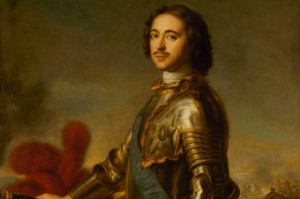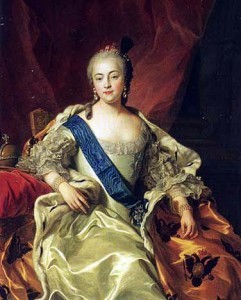Peter the Great’s hectic reign was characterized by a flurry of reforms dragging Russia into the modern era. In Cynthia Whittaker’s “The Reforming Tsar: the Redefinition of Autocratic Duty in Eighteenth-Century Russia” she discusses the emergence of enlightened absolutism initiated by Peter. Before Peter, a “good Tsar” was a man whose first obligation was to preserving the Orthodox faith; Peter redefined what it meant to be sovereign of Russia by establishing the superiority of the state over the church. He commanded that people not kneel in front of him in order to ensure the clear differentiation between God and the Tsar. The goal of enlightened absolutism was a “trickle down” effect of enlightenment and knowledge. Peter considered himself an example for his people who would hopefully learn to be as industrious and curious as he was, thus creating a generally more intelligent and efficient populace. Peter’s legacy was more influential than his own reforms as he became the model for Tsars for nearly two centuries after his death.
“Peter praise” as Whittaker called it, was the likening of a sovereign’s intentions to those of Peter’s, and it became a necessary component of a Tsar’s perceived legitimacy among the people. Every new autocrat following Peter’s death claimed he or she would continue Peter’s works and it gave him or her legitimacy. Even the most weak and ineffectual of rulers, such as Peter’s niece Anna Ivanovna, maintained a level of support as long as they continued to issue some type of reform. When Catherine II (The Great) ascended to the throne in 1762 she legitimized herself by reforming the senate, the armed forces, and secularizing church lands. She was granted the title “The Great” by the senate after she had issued the progressive Nakaz which gave principles for how high government officials and the Tsar should act. In the 1770s, scholarly opinion of Catherine began to turn as many began to be concerned with unlimited monarchs inevitably becoming tyrants. This trend continued and many Russians started to believe that the only way a Tsar would ever forsake absolute power in favor of a constitutional monarchy would be if a successful revolution occurred. This revolution would not occur until 1917, but the autocracy held power for the century leading up to it partially thanks to the myth of the “reforming Tsar.” It was assumed by some that if each new sovereign continued to issue progressive reforms, the development of some form of constitutional monarchy was inevitable, but the reforms served only to delay the collapse of enlightened absolutism.
Works Cited
Whittaker, Cynthia. “The Reforming Tsar: The Redefinition of Autocratic Duty in Eighteenth-Century Russia.” Slavic Review no. 51 (1992): 77.
http://constructionlitmag.com/wp-content/uploads/2013/05/peter-the-great-e1367796598197.jpg


